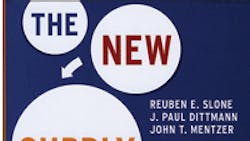Subtitled "The Five Steps that Drive Real Value," this book appears to be aimed at companies that are still on the fence about the value of supply chain management. The five steps are very basic (which doesn't necessarily mean they're easy to achieve; even the best supply chain organizations are challenged by these goals):
1. Pick the right leaders and develop supply chain talent.
2. Keep up with supply chain technologies and trends.
3. Eliminate crippling cross-functional disconnects.
4. Collaborate with suppliers and customers.
5. Implement a disciplined process of project and change management.
For instance, the book relates how supply chain partners OfficeMax and label maker Avery Dennison moved beyond a typically adversarial relationship to one based on collaboration. An important first step, and a step that many companies tend to ignore (ultimately dooming their supply chain projects), was establishing a joint steering committee that allowed members from both companies to get to know each other, and then to set mutual goals.
Through these meetings, the companies discovered they shared the same vision of leveraging continuous-improvement techniques to improve warehouse operations. One process in particular, known as objectives-goals-strategies-measures (OGSM), aligned the supply chain teams from both companies, while a joint value-stream mapping project identified opportunities for improvement. As a result, in-stock fill rates rose from below 95% to nearly 99%, forecast accuracy improved by more than 30% and inventory turnover increased by 9%. None of those improvements could have happened, though, state the authors, without first establishing a relationship based on trust.
See Also:
• Goodbye Big Three, Hello Supply Chain
• The 3PL Market Slump is Over
About the Author
Dave Blanchard
Senior Director of Content
Focus: Supply Chain
Call: (941) 208-4370
Follow on Twitter @SupplyChainDave
During his career Dave Blanchard has led the editorial management of many of Endeavor Business Media's best-known brands, including IndustryWeek, EHS Today, Material Handling & Logistics, Logistics Today, Supply Chain Technology News, and Business Finance. He also serves as senior content director of the annual Safety Leadership Conference. With over 30 years of B2B media experience, Dave literally wrote the book on supply chain management, Supply Chain Management Best Practices (John Wiley & Sons, 2010), which has been translated into several languages and is currently in its second edition. He is a frequent speaker and moderator at major trade shows and conferences, and has won numerous awards for writing and editing. He is a voting member of the jury of the Logistics Hall of Fame, and is a graduate of Northern Illinois University.
